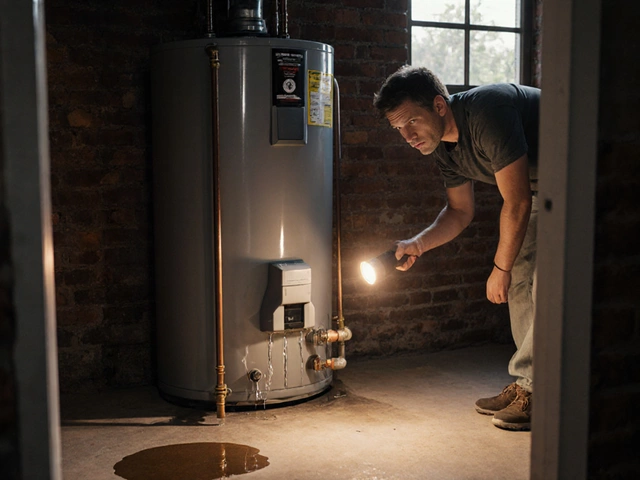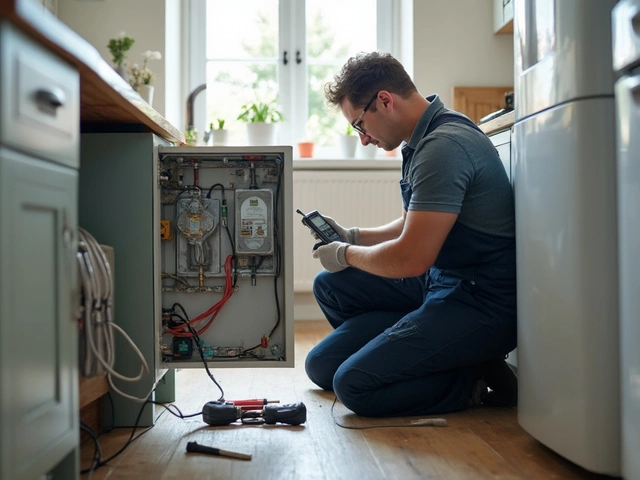Electric ovens can be temperamental, right? One minute they're cooking your pizza perfectly, the next, they're giving your cookies the cold shoulder. If you're facing oven issues, the good news is that not every problem means you're due for an appliance shopping spree. Often, many oven problems can be fixed without diving into a new purchase.
Before you start worrying about costly repairs, it could be a simple fix. Maybe the heating element needs a swap-out or the thermostat is taking a little break. Understanding what might be causing your oven's rebellion is the first step. Most issues, like a burned-out element or a defective control board, might sound technical but aren't too hard to tackle.
Now, I'm not suggesting to turn you into an instant repair guru, but with the right guidance, you might save yourself some cash. Checking the power source, ensuring the oven is properly plugged in, or even just resetting the appliance could sometimes solve the problem. And hey, working with ovens might sound a bit daunting, especially with all those wires—but don't sweat it. Keeping safety precautions at the forefront will make sure everything goes smoothly.
- Understanding Common Issues
- Basic Troubleshooting Tips
- When to Call a Professional
- How to Extend Your Oven’s Life
- Safety Precautions
- Signs That It's Time for a New Oven
Understanding Common Issues
So, what’s really going on when your electric oven acts up? Most of the time, it boils down to a few typical culprits. Let's break it down so you don’t have to scratch your head next time your oven decides to go on strike.
1. Heating Element Failures
These are the usual suspects when things get cold in your oven. If your oven is not reaching the temperatures it should, the heating element might be busted. Give them a look; if they’re dark and not glowing, they likely need replacing. It's one of the most common fixes and something you might be able to do yourself with a quick trip to the hardware store for a replacement.
2. Temperature Control and Thermostat Issues
Your oven’s thermostat is the boss of temperature control. If your meals are coming out burned or undercooked, the thermostat might be on the fritz. You can test it using an oven thermometer to see if temperature readings align with what you've set. If it seems off, replacing the thermostat might fix the issue.
3. Faulty Wiring
Nobody wants to mess around with faulty wiring, but sometimes the problem is right at the back of your electric oven. A visual inspection could show if wires are damaged or disconnected. It's critical to switch off the power before poking around. Electricity is no joke!
4. Control Board and Knob Malfunctions
Electronic control boards might seem 'out of our league' but sometimes resetting them can resolve issues. If your touchscreen or timer isn’t responsive, simply cycling the power can help. For knob-controlled ovens, worn-out dials might be an issue. They've been cranked one too many times; thankfully, they're usually easy to replace.
One useful stat: about 25% of oven repairs are minor fixes. Check out this table highlighting some common issues and average repair times:
| Issue | Estimated Repair Time (hours) |
|---|---|
| Heating Element | 1-2 |
| Thermostat | 2-3 |
| Minor Wiring | 1-2 |
| Control Board | 3-4 |
These common issues cover the majority of electric oven troubles. Remember, if you find yourself in over your head, don't hesitate to call in a professional. Better safe than sorry, especially with appliances that could give you a shock—literally!
Basic Troubleshooting Tips
So, your electric oven is acting up, and you're thinking of cracking it open like a mystery novel? Hold your horses! Here’s a step-by-step to get started with troubleshooting some common headaches. You might save more than just a few bucks by trying these out first.
Check the Power Supply
This might seem too obvious, but sometimes the root of the problem is right under our nose. Make sure your oven is properly plugged in and that the circuit breaker hasn't tripped. Give that breaker a nudge if you suspect it's been switched off.
Inspect the Heating Element
If your oven’s got its cool face on instead of heating up, the heating element could be the culprit. Look for any visible damage. If it’s burned out, it’s time to roll up those sleeves and either replace it yourself or call a tech.
Thermostat Troubles
A thermostat that’s out of whack means your oven can’t tell hot from cold, making it about as effective as a chocolate teapot. You can test this by placing an oven thermometer inside and comparing readings. If there’s a big difference, your thermostat might need some loving.
Inspect the Door Seal
If heat is escaping, not only is cooking uneven, but it’s also wasting energy. Check the door seal or gasket for any rips or poor fit. Replacing a damaged one is usually straightforward and can make a significant difference.
Control Board Check
If digital controls are going haywire or unresponsive, a control board reset might be in order. Unplug the oven for a few minutes, then plug it back in and see if it behaves better. If not, you could be looking at a deeper issue, possibly a faulty control board.
| Common Issue | Possible Cause | Solution |
|---|---|---|
| Oven not heating | Burned-out element | Replace heating element |
| Uneven cooking | Faulty thermostat | Calibrate or replace thermostat |
| Door not closing | Worn gasket | Replace door gasket |
Taking a few moments to troubleshoot can save you a trip to the appliance store and a nice chunk of change. And remember, if you're ever unsure, don't hesitate to call in the pros before diving in too deep!
When to Call a Professional
Deciding whether to call in a pro for your electric oven problem can be tricky. You're probably thinking, "Can I handle this on my own?" Sometimes, calling an expert is the best bet, especially if you're dealing with complex issues. Here are some situations where getting professional help makes sense.
Electrical Issues
If your oven's completely unresponsive, it might be an electrical problem. Messing with electricity isn't safe unless you know what you're doing. Leave it to the electricians if the circuit breakers keep tripping or if there's a burning smell; safety first, right?
Complex Parts and Components
Navigating the guts of an oven isn't always straightforward. Some parts, like control boards or intricate wiring, require special tools and expertise. Handling these without proper knowledge can do more harm than good.
Advanced Diagnostic
If you've tried basic troubleshooting and the oven still isn't cooperating, a professional can quickly pinpoint the issue. They can save you loads of time and ensure that the solution works long-term.
Warranty Considerations
Check if your oven is under warranty. Attempting repairs yourself might void the warranty. Professionals can fix issues without putting your coverage at risk. It's a smart financial move!
Preventing Further Damage
Attempting repairs without knowing the ropes can sometimes lead to bigger problems down the line. Getting a professional involved can prevent further damage and give you peace of mind.
| Common Problems | Recommended Action |
|---|---|
| Oven doesn't heat | Call a professional |
| Weird noises | Inspect initially, then call if needed |
| Error codes | Check manual first, then call |
Remember, when in doubt, calling an expert is often worth it. They’ve got the experience and skills to tackle the nitty-gritty details that might be out of reach for a DIY fix. Better safe than sorry!

How to Extend Your Oven’s Life
Getting the most mileage out of your electric oven doesn't have to be rocket science. With just a bit of regular TLC, your kitchen buddy can serve you well beyond its prime. Here’s how to ensure your electric oven remains in top-notch condition.
Regular Cleaning Routine
First things first, keeping your oven clean is a game-changer. Grease and food particles can build up over time, causing issues with functionality. Make it a habit to clean the interior with a mix of white vinegar and baking soda every few months. Don’t forget about the oven door—use a warm, soapy cloth to keep it streak-free and ensure the seal is tight. A clean oven not only looks good but functions better too!
Check the Oven Seals
Oven seals, also known as gaskets, are crucial for maintaining temperature accuracy. Over time, they can wear out and let heat escape, making everything cook unevenly. Be sure to regularly inspect them for rips or gaps. If you see any damage, replacing them is a cheap and easy fix that can drastically improve performance.
Inspecting and Maintaining Heating Elements
Without the heating elements, your oven is just a box, right? Make sure they're in good condition and replace them if they show signs of wear, like visible breaks or burn marks. This is something you can do yourself with the right replacement part and a bit of patience.
Run Regular Checks
A monthly quick check can do wonders. Ensure the oven is heating to the correct temperature—you can use an inexpensive oven thermometer for this. Miscalibration or incorrect temperatures are common problems, but easy to identify with regular checks. Make adjustments to the settings if necessary.
Handle with Care
Sometimes, it's the little things that count. Be gentle when opening and closing the oven door to avoid loosening hinges or damaging seals. Don’t slam the door shut; it might seem minor but it can lead to bigger issues down the line. Respect your oven, and it’ll respect your meals!
Data Insight: Average Lifespan Expectancy
To give you an idea of what you’re working with, here’s a quick look at how long electric ovens generally last with proper care:
| Oven Type | Average Lifespan |
|---|---|
| Basic Electric Oven | 10-15 years |
| High-End Models | 15-20 years |
Remember, these numbers are averages—treat your oven well, and it could surprise you with a few more good years.
With these tips in your toolkit, you'll be baking and roasting to perfection for many meals to come. Keep the oven love going strong, and enjoy the delicious results!
Safety Precautions
Dealing with an electric oven? Safety should be your first concern. It's crucial to avoid any mishaps, especially when dealing with electricity and potentially hot components. Here are some safety tips that'll keep you out of trouble.
Before You Start
First things first, always unplug your oven before performing any repairs. It sounds basic, but it's the most important step to preventing electric shocks.
"Never attempt to repair an electric appliance without disconnecting it from the power source," advises the U.S. Consumer Product Safety Commission.
Make sure you have the right tools and a clear work area. Tripping over something in the middle of a fix isn't just annoying—it's dangerous.
Working with Components
- Wear Gloves: This can protect you from sharp edges inside the oven.
- Use Insulated Tools: These reduce the risk of shocks. They're your best friends when working with electrical components.
Now, if you need to test parts of your oven while it's plugged in, like checking if a thermostat is working, proceed with extreme caution. It's better to call in a pro if you're unsure.
After the Fix
Once you're done with the repair, turn the appliance back on and test it from a safe distance. Ensure everything is functioning as expected before you dive back into cooking.
Remember, a quick DIY save might be tempting, but if an issue seems too complex, it's worth getting a professional's opinion to keep things safe and sound.
Signs That It's Time for a New Oven
Wondering when it's time to say goodbye to your trusty electric oven? Although some issues can be solved with simple repairs, there are telltale signs that might mean it's time to start looking for a replacement.
It Frequently Breaks Down
If your oven feels like it's on vacation more than it's working, that's a bad sign. Constant breakdowns, especially after repeated repairs, suggest it's losing its reliability. Rather than pouring more money into an old appliance, consider investing in a new, efficient model.
It's Not Heating Properly
A fix oven effort is sometimes as straightforward as replacing a faulty heating element. However, if your oven consistently fails to reach or maintain the desired temperature, it may be an issue with the thermostat or even more deeply rooted problems. If your soufflé's never rising quite right, it might be time to move on.
Your Energy Bills Are Skyrocketing
Your oven could be secretly draining your bank account. Older models tend to be less energy-efficient, leading to higher monthly energy bills. Swapping your vintage unit for a newer model could save you cash in the long run and be kinder to the planet as well.
It's Over 15 Years Old
Just like humans, ovens age. If your oven is over the 15-year mark, it's living on borrowed time. Technology has advanced significantly, so an upgrade could mean better features and enhanced performance. Plus, who doesn't love an updated kitchen appliance?
| Age of Oven | Expert Recommendation |
|---|---|
| 0-5 years | Fix if possible |
| 5-10 years | Consider replacements for major issues |
| 10-15 years | Prepare for a replacement |
| 15+ years | Replace |
If these red flags sound like your oven, it may be best to start shopping around for new options. As tempting as it is to hold onto something familiar, replacing it can ultimately save time, provide better performance, and introduce the newest sleek designs to your kitchen space.





